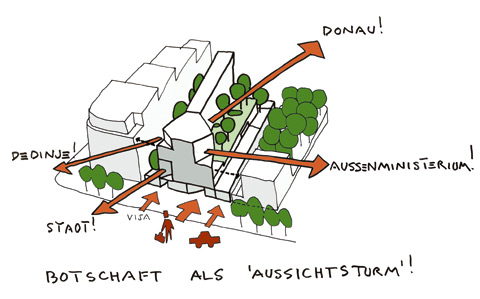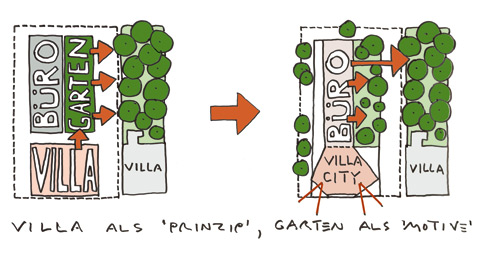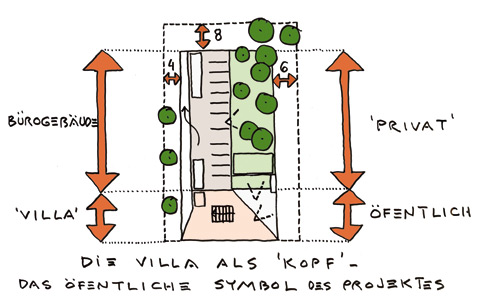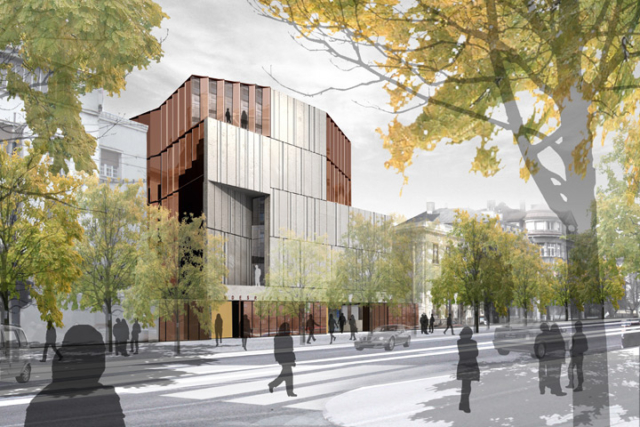bevk & perović arhitekti
projekat: Nemačka ambasada, Beograd
adresa: Ulica Miloša Kneza 74-76
klijent: Federal Office for Building and Regional Planning, Berlin, Germany
ukupna podna površina: 5600 m2
projektantski tim: Matija Bevk, Vasa J. Perović, Gerrit Neumann, Anja Vidic, Jure Grohar, Gonzalo Piqueras, Tina Marn, Ida Sedušak, Blaž Hartman
Novi objekat Nemačke Ambasade u Beogradu je lociran na jednoj od najznačajnijih gradskih lokacija, formirajući »greben« od ambasada u Ulici Kneza Miloša, u osi koja povezuje zgradu Skupštine i Vlade sa Dedinjem. Intenzivan istorijski kvalitet okruženja isto kao i činjenica da se pravi nova zgrada, određuje projekat.
Zgrada ambasade danas nije više istorijski model »palate«, nešto arogantno u svom prisustvu u gradu. Njena nova uloga je jedna »sofisticirana mašina«, koja predstavljajući svoju zemlju, njene političke, ekonomske i kulturne vrednosti i ambicije, takođe pokušava da poštuje i okruženje i grad u kome se nalazi.
Novi objekat Nemačke Ambasade u Beogradu pokušava da postigne sledeće: višestruku funkcionalnost, da bude kvalitetno i prijatno radno okruženje za radnike, ali i da svojom arhitekturom prezentuje politiku i javni program nemačke vlade u stranoj zemlji. Takođe, trebalo bi da poštuje istorijski milje grada, ispunjavajući sve veće zahteve za bezbednost.
Zbog toga, projektom se predlaže podela na standardni poslovni prostor pozicioniran u zadnjem delu parcele; postižući karakteristike vile, javni front prema ulici, sadrži reprezentativne sadržaje: veliki javni foaje, sobe za sastanke i apartman za ambasadora i zamenika ambasadora, na vrhu objekta.
Bezbednosni zahtevi se definišu prema ulici Kneza Miloša, čija je fasada kontakt objekta sa javnošću, predlažući veliki, puni fasadni zid, platno – projektovano kao masivna betonska konstrukcija, sa nekoliko velikih otvora za ulaze i veze do velikog javnog foajea na prvom spratu; i sa kulminacijom u vidu kancelarije ambasadora na poslednjem spratu, koja je okrenuta ka ulici, kao »oči« objekta, okrenute ka gradu.
Predviđeni materijali za izgradnju novog objekta odražavaju dvostranu prirodu objekta: dok spoljni fasadni izgled stimuliše ideju o čvrstoj i jakoj građevini, dodvoravajući se gradskim uslovima, sa druge strane enterijer nudi smiren i velikodušan izgled visoko kvalitetne poslovne zgrade. Dva osnovna materijala koja su korišćena da bi se postigla ideja o dualitetu, su svetlo obojeni beton i tamni bronzani metal. Koristeći jednostavne, dugotrajne i materijale jednostavne za održavanje, objekat takođe pokušava da bude uzor za buduće urbane regeneracije okruženja.
Nemačka Ambasada u Beogradu će, sa svojom pažljivom interpolacijom u gradsko tkivo, ali takođe sa svojom pravom merom atraktivnosti i dostojanstva,reprezentativnosti i efikasnosti, postati svetionik za zemlju i za grad.
bevk & perović architects
project: German Embassy, Belgrade, 2009
address: 74-76 Miloša Kneza, Belgrade, Serbia
client: Federal Office for Building and Regional Planning, Berlin, Germany
total floor area: 5600 m2
project team: Matija Bevk, Vasa J. Perović, Gerrit Neumann, Anja Vidic, Jure Grohar, Gonzalo Piqueras, Tina Marn, Ida Sedušak, Blaž Hartman
The new building for the German Embassy in Belgrade is set on one of the most prominent city locations, forming part of the “ridge” of embassies on Kneza Miloša street, in the axis connecting the parliament building to the residential neighbourhood of Dedinje. An intense historical quality of surroundings as well as a strong “gesture” of making a new building determines the project.
An embassy building today is no longer a historical model of “palace”, somewhat arrogant in its presence in the city. Its new role is one of a “sofisticated machine”, that – while representing its country, its political, economical and cultural values and ambitions, also tries to be respective to its surrounding and its host city.
The new building for the German Embassy in Belgrade is aiming to achieve this goals: it should work, be a high-quality and pleasurable office environment for workers, but it should also represent – with its public programme German government in another country. Moreover, it should respect the historical fabric of the city, while respecting an ever-increasing demands for security.
Therefore, the project proposes a “split” – division of programme into a “standard” office program, positioned in the back of the site, while establishing a “villa” condition, a “public head” towards the street, containing representative programmes – large public foyer, meeting rooms and ambassador/deputy ambassador “suite” on top.
The security demands are met by a building which towards Kneza Miloša street – its “vulnerable” point of contact with the public domain, proposes a large, very closed blank “canvas” elevation – a massive concrete construction, while allowing a few large openings for entrances and glimpses to large public foyer on the first floor and culminating with ambassadors office suite on the top floor, which “face” the street, like the “eyes” of the building, facing the city.
The materials used for contruction of the new building reflect the 2-sided nature of the programme: while the external street appearance stimulates the idea of a sturdy, strong monolith, bending to “accomodate” the surrounding city conditions, the interior elevations offer calm, generous image of a high-quality office building. The two main materials used to achieve the idea of duality are light coloured prefabricated concrete and dark bronze metal. By using the simple and long-lasting, low maintenance materials, the building also tries to be respect its use as a role-model for further urban regeneration of the surrounding area.
Therefore, a new German embassy Belgrade will, with its careful interpolation into city fabric, but also with its “right measure” of attraction and dignity, representation and efficiency, become a “beacon” for the country and a beacon in the city.












